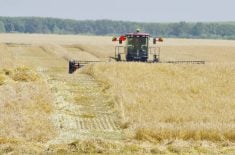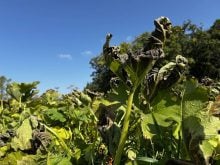Southwest Region
Dry warm conditions over the past week continued to ripen crop prematurely.
Harvest of winter wheat and fall rye continues with average yields and good quality.
Majority of spring cereal crops have been harvested, with several producers swathing to aid in crop dry down. Yields reported are average, with good quality and higher protein levels.
Read Also

How much nitrogen can farmers really cut?
Manitoba fertilizer trials look for nitrification inhibitor sweet spot, to lower greenhouse gas emissions and cost without hurting yield.
Canola crops are turning and several fields are being swathed. Earliest harvest fields are reporting slightly below average yield with good quality.
Flax crops are turning but harvesting has not occurred yet.
Soybeans are in the pod fill stage and are suffering from the hot dry conditions. Some areas are seeing leaf drop and drying out of top pods.
Sunflowers and corn continue to develop, but dry conditions are starting to effect both head and cob fill.
Pastures showing impact of heavy grazing and dry conditions. Some producers have started feeding on pasture. Several producers talking about feed and straw shortages.
Dugouts are about 50 per cent full.
Northwest Region
Harvest has begun in the reqion, except for in The Pas. Good harvest conditions this week, with some cooler nighttime temperatures and no rainfall. Very dry conditions continue in the Ste. Rose area.
Pre-harvest treatments on spring wheat continued last week in the Swan Valley area, with some fields harvested. Many spring wheat fields in the Ste. Rose, Dauphin and Roblin areas were harvested over the weekend – no word of yield or fusarium issues as of yet.
Field peas are approximately 95 per cent harvested, with no yield reports. Late seeded peas expected to be harvested this week.
Canola swathing started, with the exception of The Pas, where canola is just starting to turn color.
Soybeans are mostly at the R5 to R7 stages. Flax in the Roblin area is approximately 60 per cent ripe.
Second cut hay harvest continues in areas that received sufficient precipitation. Roughly, 50 per cent of alfalfa stands around Dauphin and Ste. Rose will not be harvested, due to minimal regrowth. Hay is being cut in low-lying areas. Cereal silage harvest continues with yields reported as average to above average.
Pastures in the Dauphin and Ste. Rose areas are in poor condition and dugouts levels estimated at 40 to 50 per cent full. Pasture conditions rated fair to good for Roblin and Swan River and dugout levels estimated at 80 to 100 per cent full.
Central Region
Warm and dry weather continues, providing favourable harvest conditions. Night temperatures were moderate to cool providing some relief to the later maturing crops. Harvest yields reported are variable, with higher yields on western side of region on the escarpment where moisture was not as limited.
Winter cereals harvest is completed. Yield ranges reported are 30 to 80 bu/ac for winter wheat and 40 to 90 bu/ac for hybrid rye with good quality reported.
Field peas harvest is mostly complete with yields reported as 30 to 80 bu/ac with good quality.
Spring wheat harvest has progressed, with some producers finished. Yield range reported are 40 to 90 bu/ac with good grade, protein levels and low fusarium damage.
Oats fields are ripe and swathing or direct harvesting occurring. The earliest fields reported yield range of 70 to 120 bu/ac. Barley harvest is mostly complete, reported yield range is 60 to 100 bu/ac with good bushel weight and low fusarium. Harrowing of cereal straw is occurring as fields are harvested, but other tillage is limited until sufficient precipitation occurs.
Corn is in grain filling and dough stage, but suffering from the lack of moisture. Sunflower in R6 to R7 stage and starting to dry down.
Soybeans are in the full seed (R6) to beginning maturity (R7) stages and most advanced in the Red River valley. Moisture stress is evident, with premature ripening.
Canola fields are maturing rapidly and being prepared for harvesting. Earliest harvested fields reported with yield range of 30 to 50 bu/ac in Altona to Somerset areas. Flax bolls develop complete with as much as 80 per cent of brown bolls reported. Some swathing is occurring.
Edible bean fields are maturing prematurely and fields are turning rapidly.
Irrigation continues on potato fields. Some potato fields have been desiccated to terminate top-growth ahead of harvest.
Pasture conditions continue to deteriorate from dry weather. Hay yields below normal. To help make up for the hay crop shortfall, roadside ditches and dried up sloughs are being cut. High nitrate levels in green feed were reported in the Gladstone area due to the dry conditions. More cereal straw than usual being baled to make up for the forage shortfall. Livestock producers are sourcing alternative feed sources to meet their needs.
Livestock water supply considered adequate, but dugout water levels estimated at less than 40 per cent full.
Eastern Region
Past week was hot and dry with no notable rainfall. Soil moisture conditions rated as 50 per cent adequate and 50 per cent short in northern and central areas; in southern area soil moisture rated as 50 per cent short and 50 per cent very short. Crop stress due to lack of moisture evident in soybeans, corn and sunflowers.
Almost 90 per cent of spring wheat harvested, with reported yield range of 50 to 70 bu/ac with good quality and protein.
70 per cent of oats acres harvested, with reported yields range of 80 to 130 bu/ac. Some reports of lower than average yields and bushel weights due to a lack of rain noted in southern and central areas.
Canola swathing and pre-harvest spraying completed with 5 per cent of acres being combined.
Soybean in the R6 growth stage in northern part of region, except for very short season varieties which were in R7. In drier, central and southern areas, soybeans were in very late R6 or had moved to R7. Soybeans prematurely ripening due to dry conditions.
Sunflower growth stages ranged from mid to late R7 to early R8. Wilting of lower sunflower leaves on hot days noted. Corn ranges from early/mid dough to early dent stage and advancing rapidly in the drier areas. Lower leaf wilting and die back evident.
Hay and pasture land moisture conditions rated as 50 per cent short and 50 per cent very short. Pasture conditions were rated as 30 per cent fair, 40 per cent poor and 30 per cent very poor. Livestock producers are 90 per cent done haying. More straw than normal baled as producers are short of hay and pastures are drying up fast. Some producers supplementing with hay on pasture. Some dugouts have gone dry and producers are moving livestock to pastures with water. Winter feed supplies of hay, straw and greenfeed rated as inadequate with the feed grain supply rate as about 80 per cent adequate.
The availability of livestock water is 80 per cent adequate, 20 per cent inadequate. Dugouts estimated to be 20 per cent full.
Interlake Region
Crops advancing rapidly as hot temperatures continued with minimal rainfall. Overnight temperatures have cooled off, giving a break from the daytime heat.
Most crops are shorter than normal, a result of extended dry periods; lighter textured soils are most impacted, with lower yields. Higher yields indicate fields that received timely rains. Some lower cereal yields are due to hail damage.
Fall rye harvest complete with yields report range of 70 to 90 bu/ac in hybrid fall rye, with lower yields in non-hybrids.
Estimated that 75 per cent of spring wheat harvested in southern Interlake. Yield range of 30-80 bu/ac with good quality, high protein and limited fusarium.
Swathing continues in spring cereals where staginess is an issue. Early barley yields reported 35 to 80 bu/ac, some reports of lighter weight. Oats are yielding 40 to 120 bu/ac. Harvest is slow, as straw on the green side. Crop grades range from #2 to #4currently, due to lower test weights.
Field pea harvest finished with reported yield range of 25 to 65 bu/ac.
Most early seeded canola swathed or intended spraying in straight cut fields complete. A few early harvested fields reported yields at 20 to 40 bu/ac with good quality.
Flax fields are changing colour rapidly, with significant brown boll reached. Fababeans have been desiccated.
Soybeans look good, but pod fill is a concern in fields not getting the rains. Leaf colour change and leaf drop is noticeable in early maturing varieties and on lighter textured fields; most fields are R5-R7. Corn is as advanced as the dent stage. Sunflowers range from R5 to R7. Seed alfalfa fields are ripening.
Continued hot and dry weather has reduced or halted pasture growth.
Minimal second cut alfalfa, cattle being turned out onto hayfields to extend the grazing season. Some coarse hay is still being put up in low-lying areas. Cereal straw being baled post-harvest for livestock.
Water is being pumped and hauled for livestock consumption; water quality in dugouts is poor and estimated to be 20 per cent full.














